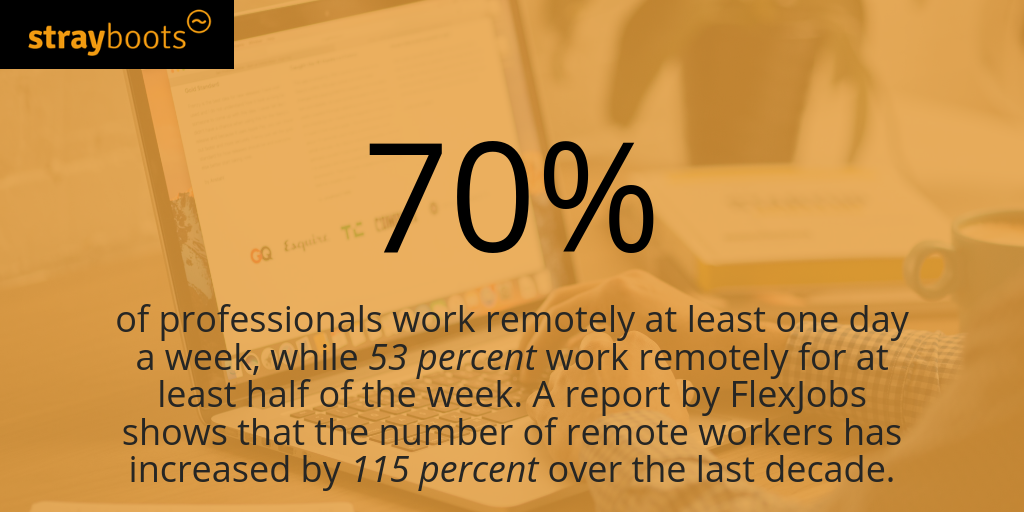Flexible Workplace Options on the Rise Despite the Challenge of Employee Engagement
Working remotely can most definitely have its perks. The average American commute to work is 26.1 minutes (which equals 4.35 hours per week, 200+ hours per year), according to the U.S. Census Bureau, and commutes in and around big cities are often much much longer. Time saved avoiding traffic can be time spent on work or with family. And then, of course, there are other perks, such as the ability to wear your fuzzy slippers all day long and throw a load of laundry in between conference calls.

However, the downside of remote work is isolation and the risk that employees feel disconnected. According to a study by Harvard Business Review, remote workers and the managers tasked with keeping them focused and engaged face inherent challenges. Out of the close to 1,200 employees polled, many feel their colleagues don’t treat them equally and they are more likely to report feeling mistreated. They also often feel left out and find that changes are made to a project without their knowledge. As the popularity of telecommuting grows, what can companies do to keep remote workers happy and engaged?
A Growing Trend
There are, of course, pros and cons for businesses to consider when it comes to allowing or encouraging remote working:
Pros:
• Less time spent commuting, potentially resulting in a reduction of absenteeism and improved employee retention.
• The ability to tap a wider pool of applicants not restricted by geography.
• Reduced business real estate costs.
• The potential for greater productivity (Standford University study, employees who work from home are 13 percent more productive than their in-office counterparts).
Cons:
• Lack of human interaction and collaboration may lead to feelings of isolation for some workers as well as challenges with “switching off.”
• Potential distractions such as laundry, cleaning, and running errands can lead to a decrease in productivity for some workers.
• Unhealthy lifestyle pitfalls such as a more sedentary routine and lack of proper office equipment such as ergonomic chairs or standing desks can have long-term effects on your health and well-being.
• In some companies, telecommuting workers report feeling less valued than in-office teammates.
The Remote Working Trend
Despite the challenges, the trend toward more remote working continues. According to a study released last year by Zug, a Switzerland-based serviced office provider found that 70 percent of professionals work remotely at least one day a week, while 53 percent work remotely for at least half of the week. A report by FlexJobs shows that the number of remote workers has increased by 115 percent over the last decade.
Data indicates remote working is not going anywhere anytime soon, so it is incumbent upon employers who embrace remote working to provide the right tools and opportunities for their employees to be successful no matter where they are based.

Finding a Solution
There are a variety of solutions and activities that can be executed to help remote workers feel engaged despite not being in the workplace, such as:
• Team retreats create an opportunity for employees to connect while experiencing new places and activities together. Buffer, for example, recently spent $111,874 to bring the company’s team of 100% remote, international workers to Sydney, Australia (a location voted on by employees). Buffer plans a retreat every 5 months (most locations not as exotic as Sydney). Other companies incorporate volunteering initiatives into their team retreats, a great way to give back while better getting to know your team.
• The popularity of team building activities that incorporate remote workers is growing. At Strayboots we are often asked to build bespoke scavenger hunts that incorporate people from home offices. We recently built a team-building scavenger hunt for a financial services company allowing remote employees to interact via teleconference. In addition, several of our clients run scavenger hunts concurrently in different cities so teams can still compete without having to be in the same place.
• Virtual coffee or snack breaks can help remote employees get to know their coworkers by chatting with one another via video call a few times a week. Information technology company Gitlab employs this strategy by encouraging their workers to spend a few hours each week joining randomly paired video calls to make remote workers feel like they, too, are a part of office culture.
• An office book club is a great way to engage not only in-office teammates but remote workers as well.
• Special employee benefits for remote workers such as covering co-working membership fees or providing monthly stipends for coffee shops instead of office space can also help remote employees get out, network, and be more energized.
There are certainly benefits to working remotely but making sure these employees are regularly engaged with their coworkers takes discipline from management. By implementing out-of-the-box activities, you can help combat isolation and help shape the future workplace environment for both in-office and remote workers.



